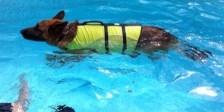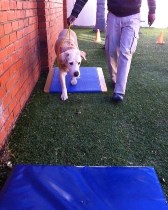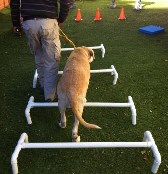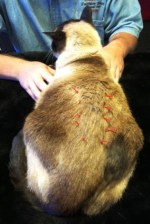

Spotlight on...Osteoarthritis
What is Osteoarthritis?
Osteoarthritis (OA), also known as degenerative joint disease (DJD), is a common disease, affecting one out of every five dogs during their lifetime. The bony surfaces of a normal joint are covered with a layer of smooth cartilage and lubricated with joint fluid. The two surfaces glide over one another. In osteoarthritis, the cartilage changes or becomes damaged so that it is less smooth and the bony surfaces rub together causing pain and further damage to the cartilage. Whilst this chronic inflammation of the joint regularly affects older dogs, even young dogs can develop this degenerative disease if they have hip dysplasia, cranial cruciate rupture, or some other joint condition or trauma. This disease is something to watch out for with any animal, but larger breeds tend to be more prone than smaller breeds, and weight is definitely a contributing factor because of the additional strain it puts on the joints and ligaments.
What are the signs and symptoms of osteoarthritis?
As a secondary disease involving chronic inflammation of one or more joints, the signs and symptoms of osteoarthritis are often seen in relation to everyday activities like walking, running, and climbing stairs. In the older pet the reduced activity levels associated with osteoarthritis may be misinterpreted as an inevitable slowing down due to age, but such decreased activity may rather signal that your pet's joints are affected by osteoarthritis. So, whether your pet is young or old keep any eye out for the following signs:
·Reduced activity level and lagging behind on walks
·Occasional lameness
·Stiffness
·Scuffing of the toenails (forelimb or hind limb)
·Excessive licking of a limb leading to lick granulomas
·Trouble getting up from a resting position
·Reluctance to walk, run, climb stairs, or play
·Changes in behaviour
·Sensitivity to being touched or avoiding being stroked or patted
·Yelping in pain
·Increasing irritability
·Difficulty getting into or out of the car
·Spending more time away from the family
·Spending less time grooming so has a scruffy coat (cats)
·Having accidents outside the litter tray/inside the house (cats)
The signs and symptoms of osteoarthritis may get worse with exercise, periods of rest, or cold weather.
If you recognise any of these signs and symptoms take your pet to the vet for a check. Your vet will be able to diagnose by examining and manipulating the joints, and by taking x-rays to look for the bony spurs affecting the joints. Your vet will also be able to rule out other causes of joint pain.
What treatments are available? How will treatment help this condition?
The bad news is that osteoarthritis is incurable and progressive. The good news is that once diagnosed osteoarthritis can be managed so as to:
·relieve pain
·reduce inflammation
·improve joint mobility
·increase activity level
·prevent further cartilage degeneration
·improve quality of life
Treatment often involves shedding some weight to reduce the load on your dog's joints and controlled exercise. The operative word here is controlled, not all exercise is going to help with those stiff and painful joints. Controlled exercise programmes will focus on strengthening muscles and joints through low impact routines, making use of various therapeutic exercises designed to target just the right areas to enhance your dog's quality of life. It is much better to take your dog for short, daily walks than to take him for one or two long walks at the weekend. Regular, consistent exercise will lead to healthier joints and so reduce pain and discomfort. Hydrotherapy is increasingly popular for osteoarthritic dogs as it enables muscle mass to be built up in a non-weight bearing environment which avoids over-stressing the joints. Such treatments should be combined with pain relief. Your vet will be able to advise you on the most appropriate medicines for your situation. In addition to pain relief, be sure to ask what chondroprotectant agents (joint supplements and joint diets) might aid repair of joint cartilage and prevent further damage.
In addition to a therapeutic exercise programme, physical rehabilitation techniques have been shown to be beneficial in assisting with maintaining and increasing joint motion and flexibility, whilst cold therapy can be used to reduce the effects of inflammation where marked swelling is present. In the absence of such swelling, heat therapy can be used to aid localised blood flow with the aim of decreasing pain and muscle spasm, and improving joint mobility. Massage therapy helps to reduce oedema, improve blood flow, and decrease muscle stiffness, whilst therapeutic ultrasound has beneficial effects at both the tissue and cellular levels. Complementary therapies such as acupuncture and laser therapy have been shown to have good results in osteoarthritic dogs and cats as it stimulates nerves, increases blood circulation, relieves muscle spasm, and relieves pain. All of these treatments can be combined to improve your pet's quality of life.
There are also changes that can be made to your dog's environment which help in the management of osteoarthritis:
·Soft, warm, padded beds away from draughts
·Covering slippery floors. Using dog boots or a product called “Soft Paws” (plastic nail covers) to stop your dog from slipping
·Ramps to help your dog get in and out of the car
·Special harnesses that you can use to assist your dog when walking
Depending on the underlying causes of osteoarthritis, surgical treatment may also be a possibility in order to alleviate pain, slow progression of the disease, remove aggravating causes, and restore limb movement.
The important thing to remember is that treatment is ongoing. This is a progressive disease and treatment can make a substantial difference to your pet's health and quality of life. Whilst the changes in a joint which result from osteoarthritis are irreversible, early diagnosis and treatment can help slow progression of the disease and prevent further degeneration of the joint. Through the reduction of pain and the promotion of strengthened muscles and improved joint mobility, a combination of the treatments detailed above can make a significant impact on your pet's quality of life.
Cats also suffer from osteoarthritis usually as a result of joint “wear and tear”. Often cats will not show obvious signs of osteoarthritis and so osteoarthritis is not always treated properly in cats. Cats with osteoarthritis will greatly benefit from weight loss, joint supplements, physical rehabilitation using therapeutic exercises, massage, acupuncture, laser therapy and even hydrotherapy. Environmental modification will help for example by placing chairs for cats to use to jump up onto and off window sills or counters and low sided litter trays.
At Southern Cross, we stock a wide range of joint diets, joint supplements, pet beds and assistive devices. We offer physical rehabilitation, acupuncture, laser therapy, pain management and veterinary chiropractic for pets. Please contact Dr Kerr for further information on any of the treatment options above. Dr Kerr can also provide home physical rehabilitation plans which include various exercises that you can do at home to help your pet.
Read more about physical rehabilitation, pain management, laser therapy, acupuncture and veterinary chiropractic for pets.
Measuring Quality of Life
Helsinki Chronic Pain Index
back to Pet Info
back to Services
back to Home
What is Osteoarthritis?
Osteoarthritis (OA), also known as degenerative joint disease (DJD), is a common disease, affecting one out of every five dogs during their lifetime. The bony surfaces of a normal joint are covered with a layer of smooth cartilage and lubricated with joint fluid. The two surfaces glide over one another. In osteoarthritis, the cartilage changes or becomes damaged so that it is less smooth and the bony surfaces rub together causing pain and further damage to the cartilage. Whilst this chronic inflammation of the joint regularly affects older dogs, even young dogs can develop this degenerative disease if they have hip dysplasia, cranial cruciate rupture, or some other joint condition or trauma. This disease is something to watch out for with any animal, but larger breeds tend to be more prone than smaller breeds, and weight is definitely a contributing factor because of the additional strain it puts on the joints and ligaments.
What are the signs and symptoms of osteoarthritis?
As a secondary disease involving chronic inflammation of one or more joints, the signs and symptoms of osteoarthritis are often seen in relation to everyday activities like walking, running, and climbing stairs. In the older pet the reduced activity levels associated with osteoarthritis may be misinterpreted as an inevitable slowing down due to age, but such decreased activity may rather signal that your pet's joints are affected by osteoarthritis. So, whether your pet is young or old keep any eye out for the following signs:
·Reduced activity level and lagging behind on walks
·Occasional lameness
·Stiffness
·Scuffing of the toenails (forelimb or hind limb)
·Excessive licking of a limb leading to lick granulomas
·Trouble getting up from a resting position
·Reluctance to walk, run, climb stairs, or play
·Changes in behaviour
·Sensitivity to being touched or avoiding being stroked or patted
·Yelping in pain
·Increasing irritability
·Difficulty getting into or out of the car
·Spending more time away from the family
·Spending less time grooming so has a scruffy coat (cats)
·Having accidents outside the litter tray/inside the house (cats)
The signs and symptoms of osteoarthritis may get worse with exercise, periods of rest, or cold weather.
If you recognise any of these signs and symptoms take your pet to the vet for a check. Your vet will be able to diagnose by examining and manipulating the joints, and by taking x-rays to look for the bony spurs affecting the joints. Your vet will also be able to rule out other causes of joint pain.
What treatments are available? How will treatment help this condition?
The bad news is that osteoarthritis is incurable and progressive. The good news is that once diagnosed osteoarthritis can be managed so as to:
·relieve pain
·reduce inflammation
·improve joint mobility
·increase activity level
·prevent further cartilage degeneration
·improve quality of life
Treatment often involves shedding some weight to reduce the load on your dog's joints and controlled exercise. The operative word here is controlled, not all exercise is going to help with those stiff and painful joints. Controlled exercise programmes will focus on strengthening muscles and joints through low impact routines, making use of various therapeutic exercises designed to target just the right areas to enhance your dog's quality of life. It is much better to take your dog for short, daily walks than to take him for one or two long walks at the weekend. Regular, consistent exercise will lead to healthier joints and so reduce pain and discomfort. Hydrotherapy is increasingly popular for osteoarthritic dogs as it enables muscle mass to be built up in a non-weight bearing environment which avoids over-stressing the joints. Such treatments should be combined with pain relief. Your vet will be able to advise you on the most appropriate medicines for your situation. In addition to pain relief, be sure to ask what chondroprotectant agents (joint supplements and joint diets) might aid repair of joint cartilage and prevent further damage.
In addition to a therapeutic exercise programme, physical rehabilitation techniques have been shown to be beneficial in assisting with maintaining and increasing joint motion and flexibility, whilst cold therapy can be used to reduce the effects of inflammation where marked swelling is present. In the absence of such swelling, heat therapy can be used to aid localised blood flow with the aim of decreasing pain and muscle spasm, and improving joint mobility. Massage therapy helps to reduce oedema, improve blood flow, and decrease muscle stiffness, whilst therapeutic ultrasound has beneficial effects at both the tissue and cellular levels. Complementary therapies such as acupuncture and laser therapy have been shown to have good results in osteoarthritic dogs and cats as it stimulates nerves, increases blood circulation, relieves muscle spasm, and relieves pain. All of these treatments can be combined to improve your pet's quality of life.
There are also changes that can be made to your dog's environment which help in the management of osteoarthritis:
·Soft, warm, padded beds away from draughts
·Covering slippery floors. Using dog boots or a product called “Soft Paws” (plastic nail covers) to stop your dog from slipping
·Ramps to help your dog get in and out of the car
·Special harnesses that you can use to assist your dog when walking
Depending on the underlying causes of osteoarthritis, surgical treatment may also be a possibility in order to alleviate pain, slow progression of the disease, remove aggravating causes, and restore limb movement.
The important thing to remember is that treatment is ongoing. This is a progressive disease and treatment can make a substantial difference to your pet's health and quality of life. Whilst the changes in a joint which result from osteoarthritis are irreversible, early diagnosis and treatment can help slow progression of the disease and prevent further degeneration of the joint. Through the reduction of pain and the promotion of strengthened muscles and improved joint mobility, a combination of the treatments detailed above can make a significant impact on your pet's quality of life.
Cats also suffer from osteoarthritis usually as a result of joint “wear and tear”. Often cats will not show obvious signs of osteoarthritis and so osteoarthritis is not always treated properly in cats. Cats with osteoarthritis will greatly benefit from weight loss, joint supplements, physical rehabilitation using therapeutic exercises, massage, acupuncture, laser therapy and even hydrotherapy. Environmental modification will help for example by placing chairs for cats to use to jump up onto and off window sills or counters and low sided litter trays.
At Southern Cross, we stock a wide range of joint diets, joint supplements, pet beds and assistive devices. We offer physical rehabilitation, acupuncture, laser therapy, pain management and veterinary chiropractic for pets. Please contact Dr Kerr for further information on any of the treatment options above. Dr Kerr can also provide home physical rehabilitation plans which include various exercises that you can do at home to help your pet.
Read more about physical rehabilitation, pain management, laser therapy, acupuncture and veterinary chiropractic for pets.
Measuring Quality of Life
Helsinki Chronic Pain Index
back to Pet Info
back to Services
back to Home



